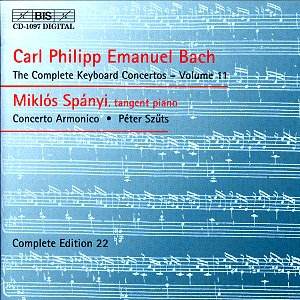|
Carl Philipp Emanuel Bach was the most illustrious
of Johann Sebastian Bach’s sons. His composing career was long and he
was quite prolific, writing dozens of sonatas, concertos and other works.
According to Miklós Spányi, there are 52 keyboard concertos and 12 sonatinas,
in addition to the many solo keyboard works.
One of the unique characteristics of this recording is
the use of a tangent piano - a sort of hybrid instrument whose character
lies somewhere between the harpsichord and clavichord. It has a beautiful
and unique sound. The down side is that it is a very soft instrument,
and it does not work quite so well with an instrumental group.
Miklós Spányi is clearly the reigning
performer of C.P.E. Bach’s keyboard music, with this complete set that
never fails to delight. Whether solo music or concertos, he has brought
original instruments (clavichord and tangent piano) to the performance
of this fine music. This disc contains two concertos and two sonatinas,
written over a span of 20 years.
C.P.E. Bach’s concertos are in the standard three-movement
form, with a wide range of melodic material, and an interesting interplay
between the soloist and the orchestra. The opening movement of the C
minor concerto on this disc is typical of this style, with perhaps a
bit more presence of the orchestra than some other concertos. The orchestra’s
sound, however, is quite dense and bass-heavy, detracting a bit from
the delightful melodies.
The two sonatinas included
here are in two-movement form, with both movements in the same key,
and the orchestra includes strings, two flutes and two French horns.
The tone is light and playful, resulting in music that is, as the liner
notes suggest, “
easy-going and easy to listen to”. The Andantino of the G major sonatina
features an attractive section where the tangent piano dialogues with
the flutes. The piano later plays some cascading harp-like themes that
reinforce the lightness and delicacy of the work.
The B flat major concerto starts out more intense, with
a slow dense movement, but ends on a more positive note, with the flutes
and horns taking the lead in the final movement, before the piano comes
in with more harp-like arpeggios. The third movement of this concerto
is one of the most attractive on the disc; the tone mixes playfulness
and intensity, combining to form an unforgettable atmosphere.
This 11th volume in this complete set of C.P.E. Bach’s
keyboard concertos comes with the usual quality performances and recording,
and all four works are attractive and enjoyable. With each new volume,
this series becomes more solidly anchored as the reference for these
works.
Kirk McElhearn
|
